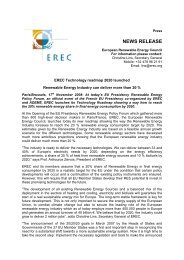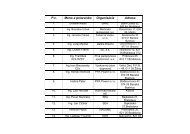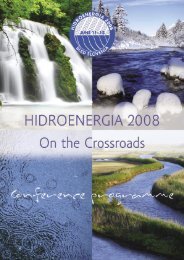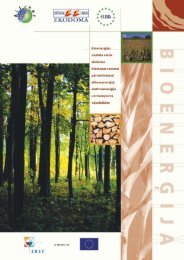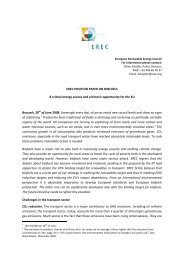Geothermal - European Renewable Energy Council
Geothermal - European Renewable Energy Council
Geothermal - European Renewable Energy Council
Create successful ePaper yourself
Turn your PDF publications into a flip-book with our unique Google optimized e-Paper software.
approximately from 2 to 4.5 €/MW,<br />
and very attractive generation costs,<br />
from 40 to 100 €/MWh. It is a resource<br />
suitable for base load power.<br />
<strong>Geothermal</strong><br />
electricity<br />
worldwide<br />
The growth of developing countries will<br />
result in a two fold increase of the global<br />
electricity demand over the next 25 years,<br />
from 15,000 TWh in 2005 to 30,000 TWh in 2030.<br />
The present renewable energy quota is 21.5%<br />
(mainly hydro), while the projected share will be<br />
25.8% in 2030.<br />
<strong>Geothermal</strong> <strong>Energy</strong> provides approximately 0.4%<br />
of the world global power generation, with a stable<br />
long term growth rate of 5%. At present, the largest<br />
markets are in the USA, Philippines, Mexico, Indonesia,<br />
Italy and Iceland. Future developments are<br />
limited to areas worldwide, particularly under current<br />
technologies. The present installed capacity of 9<br />
GW will increase up to 11 GW in 2010. It displays<br />
investment costs, depending on the quality of the<br />
resource (temperature, fluid chemistry and thermodynamics<br />
phase, well deliverability,..), ranging<br />
It can be considered as broadly<br />
cost-competitive, despite relatively<br />
high capital investment costs for<br />
the development of the geothermal<br />
field (resource assesment, mining<br />
risk, drilling and piping), owing to<br />
its very high availability and stable<br />
energy production. The next generation<br />
should be able to benefit from<br />
the implementation of the Enhanced <strong>Geothermal</strong><br />
System (EGS) production, alongside an intensive<br />
increase of low-to-medium temperature applications<br />
through binary cycles and cascading uses.<br />
<strong>Geothermal</strong> electricity potential<br />
Estimating the overall worldwide potential is a<br />
delicate exercise due to the many uncertainties<br />
involved. Nevertheless, it is possible to identify a<br />
range of estimates, by taking into consideration<br />
also the possible impacts of new technologies (permeability<br />
enhancements, drilling improvements,<br />
EGS, low temperature electricity generation).<br />
Minimum: 35,000/70,000 MW<br />
Maximum 140,000 MW<br />
It is deemed possible to produce up to a maximum<br />
of 1,000 billion kWh of electricity annually, i.e.<br />
8.3% of total world electricity production, serving<br />
17% of the world population. 39 countries (mostly<br />
in Africa, Central/South America and the Pacific)<br />
can be wholly geothermally powered<br />
World <strong>Geothermal</strong> Potential<br />
Installed Capacity Wordlwide<br />
150,000 MW<br />
12 GW<br />
10 GW<br />
100,000 MW<br />
8 GW<br />
50,000 MW<br />
0<br />
Current<br />
Today’s<br />
Technology<br />
Enhanced<br />
Technology<br />
6 GW<br />
4 GW<br />
2 GW<br />
0<br />
1980 1990 2000 2010<br />
Installed<br />
capacity from<br />
1975 up to<br />
end of 2007<br />
(light blue) and<br />
to 2010 (red).<br />
12 EGEC | <strong>Geothermal</strong> Electricity and Combined Heat & Power




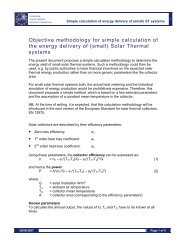

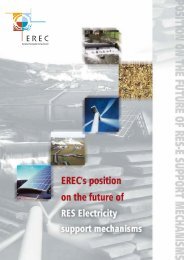

![Energy [R]evolution - Greenpeace](https://img.yumpu.com/47174859/1/184x260/energy-revolution-greenpeace.jpg?quality=85)
